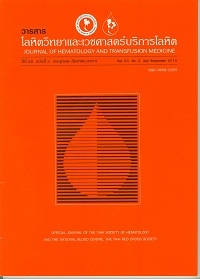การศึกษาความชุกของภาวะเม็ดเลือดขาวชนิดนิวโตรฟิลต่ำ โดยที่ยังไม่มีอาการในประชากรไทย: รายงานเบื้องต้น
Keywords:
Prevalence, Neutropenia, Idiopathic neutropenia, Chronic neutropenia, Myelodysplastic syndromeAbstract
บทคัดย่อ
Complete blood count (CBC) เป็นการตรวจที่ทำเป็นประจำรวมถึงในการตรวจสุขภาพ ด้วยการตรวจนี้ทำให้พบคนกลุ่มหนึ่งมีจำนวนเม็ดเลือดขาวต่ำหรือค่อนต่ำโดยที่ไม่มีอาการโดยบังเอิญ การพบนี้เป็นปัญหาในทางปฏิบัติเนื่องจากไม่มีค่าผิดปกติที่ยอมรับชัดเจนในคนไทย ดังนั้นจึงทำการศึกษาในชุมชนเบื้องต้นเพื่อหาความชุกของภาวะเม็ดเลือดขาวชนิดนิวโตรฟิลต่ำโดยที่ยังไม่มีอาการในประชากรไทย เพื่อเป็นแนวทางในการสืบค้นและทำการศึกษาอื่นๆ ต่อไป วิธีการศึกษา : ทำการเก็บตัวอย่างเลือดจากประชากรไทยที่อาศัยอยู่ในกรุงเทพและจังหวัดใกล้เคียงเพื่อตรวจ CBC ผู้มีภาวะเม็ดเลือดขาวชนิดนิวโตรฟิลต่ำหมายถึง ผู้มีค่า absolute neutrophil count (ANC) น้อยกว่า 1.5 x 109/L ผลการศึกษา : วิเคราะห์กลุ่มตัวอย่างทั้งสิ้น 5,964 ราย เป็นชาย 2,335 ราย (ร้อยละ 39.1) หญิง 3,629 ราย (ร้อยละ 60.9) อายุระหว่าง 18-99 ปี (ค่ามัธยฐาน 44.7 ปี) การกระจายของเม็ดเลือดขาวทั้ง white blood cell count (WBC) และ ANC เป็นแบบเบ้ขวา โดยมีค่ากลางเท่ากับ 7.27 x 109/L (ระยะระหว่างควอไทล์ที่ 1 ถึง 3 (Q1-Q3) เท่ากับ 6.10-8.66 x 109/L) และ 3.93 x 109/L (Q1-Q3 3.14-4.89 x 109/L) ตามลำดับ พบกลุ่มตัวอย่าง 22 ราย มีภาวะเม็ดเลือดขาวชนิดนิวโตรฟิลต่ำ(ร้อยละ 0.36, ค่าขอบเขตความเชื่อมั่นร้อยละ 95 (95% CI) เท่ากับ ร้อยละ 0.21-0.51) ไม่พบความแตกต่างอย่างมีนัยสำคัญทางสถิติของความชุกระหว่างเพศ กลุ่มอายุ หรือพื้นที่ที่สำรวจ สรุป : ความชุกของภาวะเม็ดเลือดขาวชนิดนิวโตรฟิลต่ำโดยที่ยังไม่มีอาการในประชากรไทยเท่ากับ ร้อยละ 0.36 (95% CI ร้อยละ 0.21-0.51) ซึ่งต่ำกว่าประชากรผิวขาวและผิวดำส่วนสาเหตุหรือปัจจัยเสี่ยงที่พบจะรายงานในการศึกษาเพิ่มเติมต่อไป
Key Words : Prevalence, Neutropenia, Idiopathic neutropenia, Chronic neutropenia , Myelodysplastic syndrome
Abstract
Background : The automated complete blood cell count is routinely used in clinical practice including health checkups. With this screening, cases with low or borderline white blood cells count (WBC) without any symptoms are occasionally detected. These are problematic because there is no well-defined cutoff point of neutropenia for Thais. Therefore, we conducted a community-based study to determine the prevalence of asymptomatic neutropenia in the Thai population for further investigation guideline and future studies. Methods : Blood specimens were collected from the population in Bangkok and surrounding provinces for CBC analyses. Neutropenic cases were those with absolute neutrophil count (ANC) below 1.5 x 109/L. Results : There were a total of 5,964 analyzed subjects, 2,335 males (39.1%) and 3,629 females (60.9%), ranging from the age of 18-99 years (median 44.7 years). The WBC and ANC distributions skewed to the right. The median WBC and ANC were 7.27 x 109/L (interquartile range Q1-Q3 6.10-8.66 x 109/L) and 3.93 x 109/L (Q1-Q3 3.14-4.89 x 109/L), respectively. Twenty-two of participants had neutropenia (0.36%, 95% confidence interval (CI) 0.21-0.51%). The prevalence in each sex, age group or site of survey showed no statistical difference. Conclusion : The prevalence of asymptomatic neutropenia in Thai population was 0.36% (95% CI 0.21-0.51%), which was lower than those of Caucasian and African-American populations. Additional studies for the associated risk factors and the causes of diseases need to be performed.
Key Words : Prevalence, Neutropenia, Idiopathic neutropenia, Chronic neutropenia , Myelodysplastic syndrome



